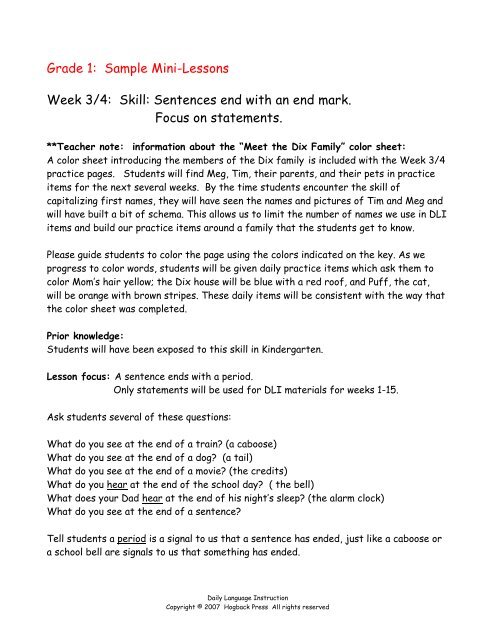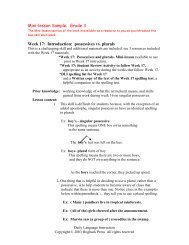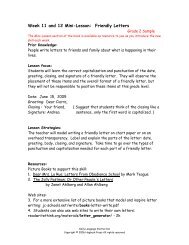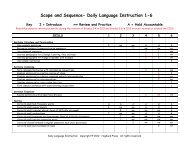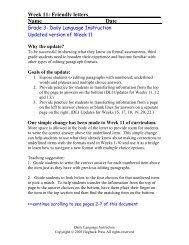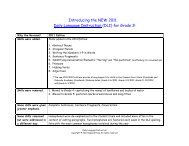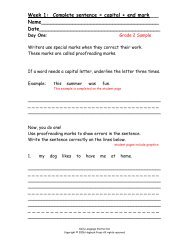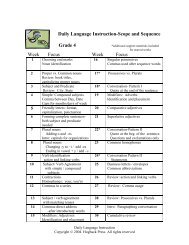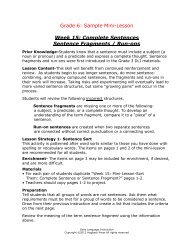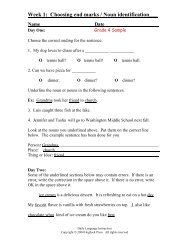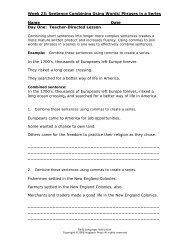Grade 1 Sample mini-lessons finalm
Grade 1 Sample mini-lessons finalm
Grade 1 Sample mini-lessons finalm
Create successful ePaper yourself
Turn your PDF publications into a flip-book with our unique Google optimized e-Paper software.
<strong>Grade</strong> 1: <strong>Sample</strong> Mini-Lessons<br />
Week 3/4: Skill: Sentences end with an end mark.<br />
Focus on statements.<br />
**Teacher note: information about the “Meet the Dix Family” color sheet:<br />
A color sheet introducing the members of the Dix family is included with the Week 3/4<br />
practice pages. Students will find Meg, Tim, their parents, and their pets in practice<br />
items for the next several weeks. By the time students encounter the skill of<br />
capitalizing first names, they will have seen the names and pictures of Tim and Meg and<br />
will have built a bit of schema. This allows us to limit the number of names we use in DLI<br />
items and build our practice items around a family that the students get to know.<br />
Please guide students to color the page using the colors indicated on the key. As we<br />
progress to color words, students will be given daily practice items which ask them to<br />
color Mom’s hair yellow; the Dix house will be blue with a red roof, and Puff, the cat,<br />
will be orange with brown stripes. These daily items will be consistent with the way that<br />
the color sheet was completed.<br />
Prior knowledge:<br />
Students will have been exposed to this skill in Kindergarten.<br />
Lesson focus: A sentence ends with a period.<br />
Only statements will be used for DLI materials for weeks 1-15.<br />
Ask students several of these questions:<br />
What do you see at the end of a train? (a caboose)<br />
What do you see at the end of a dog? (a tail)<br />
What do you see at the end of a movie? (the credits)<br />
What do you hear at the end of the school day? ( the bell)<br />
What does your Dad hear at the end of his night’s sleep? (the alarm clock)<br />
What do you see at the end of a sentence?<br />
Tell students a period is a signal to us that a sentence has ended, just like a caboose or<br />
a school bell are signals to us that something has ended.<br />
Daily Language Instruction<br />
Copyright © 2007 Hogback Press All rights reserved
A sentence does not go on and on and on. It stops after it has done its JOB.<br />
Share with students the following jobs of a sentence:<br />
Three JOBS for a sentence:<br />
1) a sentence tells what a person does, or<br />
2) a sentence tells what a thing does, or<br />
3) a sentence tells what happened.<br />
Compose some sentences together using the idea that a sentence stops when it has done<br />
its JOB. The following is a possible dialogue you might have with your students about<br />
job #1:<br />
Teacher: Since a sentence tells what a person does, could someone name a person?<br />
Student: Mom<br />
Teacher: Let’s record that name on our chart. What did we learn the last two weeks<br />
about what kind of letter we should use at the beginning of the sentence?<br />
Yes, that’s right; let’s start with a capital letter for our first word, “Mom.”<br />
Teacher: Do you think that this is a sentence? (Point to the word “Mom.”) No, you are<br />
right; this is just our first word. The sentence hasn’t finished its job, yet. It<br />
has to tell what the person does. Could someone tell one thing that Mom<br />
does?<br />
Student: Mom goes to store.<br />
Teacher: Let’s write that next to the word “Mom.” Write the words “goes to the store”<br />
but do not add a period.<br />
Teacher: Has the sentence finished its job? Does it tell who? Yes, the sentence is<br />
talking about Mom. Does it tell what Mom does? Yes, it tells that Mom goes<br />
to the store. What do you think? Has the sentence finished its job? Yes,<br />
so how do we show that this sentence has finished its job?<br />
Student: We need a period to show that it is the end of the sentence.<br />
Teacher: That is correct! A big, fat period tells us that this sentence is ending.<br />
Repeat the steps above asking students to name another person and then ask what that<br />
person does. Review the concepts as you close the lesson: a period is the signal that a<br />
sentence has ended, just like a caboose is a signal that the train has ended. Sentences<br />
do not go on and on. A sentence ends when it has finished its job. Today we learned<br />
that one job of a sentence is to tell what a person does. When the sentence finishes<br />
doing that job, it needs a period to show that it has ended.<br />
Daily Language Instruction<br />
Copyright © 2007 Hogback Press All rights reserved
On other instructional days, review the concepts from today’s lesson and then develop<br />
Job Two for a sentence… telling what a thing does, or Job Three, telling what happened.<br />
Lesson extension:<br />
The following song reinforces the lesson content. It can be used as you do interactive<br />
editing with your class and also when your students look at their own writing. The<br />
editing tune below teaches students a strategy of using their thumb and pinkie to signal<br />
the capital letter and end mark. When students look for capitals and end punctuation,<br />
this tactile approach can help students stay focused.<br />
“ My Sentence Needs a Check”<br />
Sung to the tune of “The Farmer in the Dell”<br />
Copyright © 2006 Hogback Press All rights reserved<br />
1. My sentence needs a check, 2. Thumb taps the capital,<br />
My sentence needs a check,<br />
Thumb taps the capital,<br />
Hi-ho, the Derry-o,<br />
Hi-ho, the Derry-o,<br />
My sentence needs a check.<br />
Thumb taps the capital.<br />
3. Pinkie pats the period, 4. My sentence now is fine,<br />
Pinkie pats the period,<br />
My sentence now is fine,<br />
Hi-ho, the Derry-o,<br />
Hi-ho, the Derry-o,<br />
Pinkie pats the period.<br />
My sentence now is fine.<br />
Week 7: Capital letter for I<br />
Prior knowledge: Students know that the names of people, including their own names,<br />
start with a capital letter.<br />
Lesson Focus: Use a capital letter “I” when writing the pronoun “I”.<br />
Lesson Strategy:<br />
Materials: 4” x 9” piece of bright construction paper for each student<br />
Crayons or markers<br />
Daily Language Instruction<br />
Copyright © 2007 Hogback Press All rights reserved
Remind students that we learned how special we are. That fact makes us use a capital<br />
letter when we start to write our names.<br />
Write your name on this piece of construction paper. Make sure you start your name<br />
with a capital letter.<br />
When we talk about ourselves, we don’t say, “Mary wants a drink of water.” We say, “I<br />
want a drink of water.” We use the word “I” instead of our name when we talk about<br />
ourselves. “I” takes the place of our whole name. Since our name starts with a capital,<br />
“I” must be a capital letter because it does the job or takes the place of our name.<br />
Turn your paper over and write a big, bold capital “I” to take the place of your name.<br />
Now both sides of your card are YOU, and both have capital letters.<br />
Lesson Extension: “Capital I” song<br />
“CAPITAL I” SONG<br />
(Sung to the tune of “I’ve Been Working on the Railroad”)<br />
Daily Language Instruction Copyright © 2007 Hogback Press All rights reserved<br />
I’ve been working on my capitals,<br />
All the live-long day.<br />
I’ve been working on my capitals,<br />
Just to pass the time away.<br />
When you see the letter “I”<br />
Standing all alone,<br />
Make it big and bold and capital<br />
To show that it’s your own.<br />
Week 20: Verbs are Action words<br />
Prior knowledge: This is an introductory skill- the focus will be on action verbs.<br />
Daily Language Instruction<br />
Copyright © 2007 Hogback Press All rights reserved
Lesson Focus: Students will learn that verbs are action words.<br />
Lesson Strategy: Tell students that each sentence has an action part. If the sentence<br />
is about a cat, the verb is the word that tells what the cat does. Ask students this<br />
question: “What can a cat do?” <strong>Sample</strong> responses include the following: eat, sleep, play,<br />
purr, climb, scratch, and meow. On another day you may wish to ask instead: “What did<br />
the cat do?” or “What is the cat doing?” These questions will generate verbs in past<br />
tense or past participles and you can talk about other endings common to verbs.<br />
After talking to students about verbs as action words, play the game “What Can I Do?”<br />
To play, you begin by doing an action and have students guess the verb. Emphasize that<br />
the verb will tell what you can do. When students guess the verb, record it on chart<br />
paper and build a list which you can post in your classroom. After a few examples that<br />
you perform, ask for students to volunteer to do an action and have other students<br />
guess the verb. Suggestions include the following verbs: jump, clap, hop, sing, snap<br />
(fingers), skip, sleep, yawn, whistle, write, comb, pat, pull, push, kneel, climb, and read.<br />
Mini-lesson song: teach the following song to your students and use recess as an<br />
opportunity to add more verbs to your class list.<br />
“Verbs”<br />
To the tune of “Take me out to the Ball Game”<br />
Copyright © 2006 Hogback Press All rights reserved<br />
1 2<br />
Take me out to the playground,<br />
It’s a place to find verbs.<br />
Verbs are those words that are ac-tion-packed,<br />
You swing on the swings…., then you glide back.<br />
For it’s kick the soccer ball, shoot it,<br />
The goalie lunges to save.<br />
For it’s one, two, three verbs you’ll find,<br />
On the school play-ground!<br />
Take me out to the playground,<br />
Can YOU think of some verbs?<br />
Think of the batter and pitcher, too.<br />
Verbs are words that can tell what<br />
they do.<br />
For it’s swing, slide, catch on the<br />
play-ground,<br />
If there’s an ac-tion, verbs tell!<br />
For it’s verbs that show what you do,<br />
On the school play-ground!<br />
Daily Language Instruction<br />
Copyright © 2007 Hogback Press All rights reserved


